Paris, BnF, lat. 17806
A university textbook1
This manuscript from the third quarter of the thirteenth century contains texts from the Logica vetus and the Logica nova: Aristotle’s, Praedicamenta(1-4), Periermenias (4v-15), Liber sex principium (15v-23v); Boethius’ De divisione (24-35v), Topica (36-68v); Aristotle’s De sophisticis elenchis (69-92v), Topica (93-164), Analytica priora (164v-217v), Analytica posteriora (218-249v), Praedicamenta (250-259v). In this compendium, Aristotle’s Topica, his Analytica priora and posteriora are texts that were introduced only in the twelfth century. It is a full compendium of logic, probably made in England, but in the collection of the Church of Notre Dame in Paris at least in the seventeenth century, perhaps long before. Perhaps it was the possession of an English student at the University of Paris. It was clearly designed for use at the Faculty of Arts. The content of the book, but also the lay-out are characteristic of the university book.

https://gallica.bnf.fr/ark:/12148/btv1b525053525
A Handbook of Logic from the Faculty of Arts
At the Faculty of Arts, students acquired a basic education in the art of logic, in reading at an advanced level and arguing about texts, in solving contradictions and speaking in public. From the Faculty of Arts they could progress to the Faculties of Theology, Law or Medicine. In this handbook texts from the old curriculum (Logica Vetus) are combined with new texts, translated into Latin only in the twelfth century (Logica Nova): Aristotle’s Analytica priora and Analytica posteriora, his Topica and Sophisiti elenchi.
The combination of all of these texts in one codex is characteristic for the university milieu, as is the lay-out of the book: it has a relatively small area of main text in the middle, and is surrounded by ample white space to accommodate glosses and commentaries. Multiple columns have been prepared to make sure that a single passage in the main text could get multiple explanatory notes, without giving up a clear visual placement lining it up to the right place on the page.
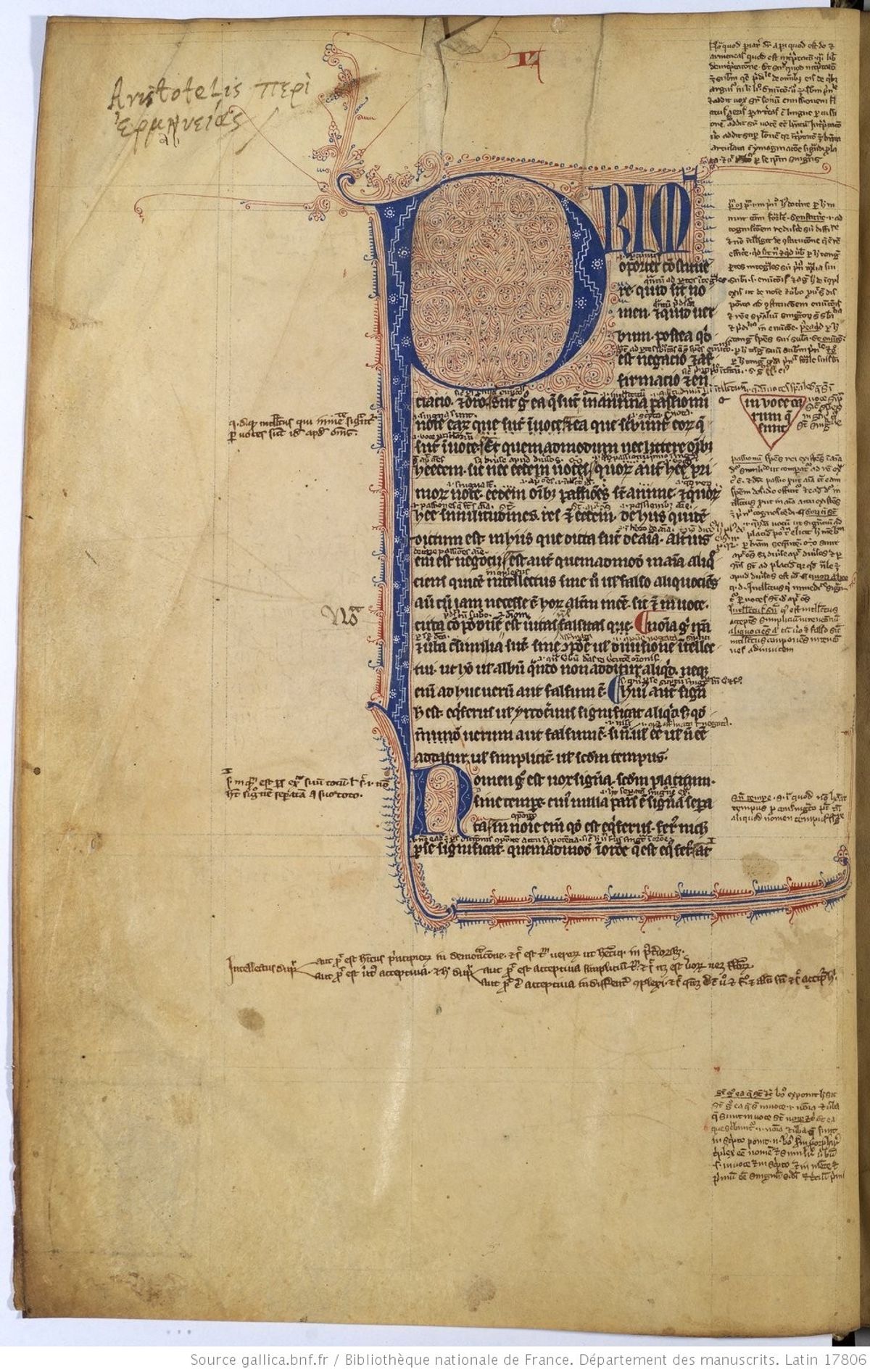

In addition to the regular writing lines, a grid is made with extra vertical and horizontal lines (here marked in light green) dividing the page into four vertical columns and four horizontal sections. The sections accommodate the comments in the margin in such a way that they line up with the main text, even when there are multiple comments to one passage. Digressions or excursive comments are generally placed in the upper and lower margins.

https://gallica.bnf.fr/ark:/12148/btv1b525053525
A close up shows how exquisite and detailed the penwork is. The size of the initial signifies the structure of the text: the larger the initial, the more important the unit of text is it opens. Red and blue are the usual colours of ink to use for these initials and the penwork, often in alternation.

https://gallica.bnf.fr/ark:/12148/btv1b525053525
In the red triangle we read: “in voce earum quae sunt”. This is a correction for a passage in the main text, which originally read “que sunt in voce”. In the main text, the passage is marked with dots under the letters, signifying that these words should be deleted and replaced by the correction in het margin.

https://gallica.bnf.fr/ark:/12148/btv1b525053525
The writing of the glosses was tiny and precise. Underlining was used to mark the quoted text. In this type of book, text is generally highly abbreviated. The readers were professionals: they would have been familiar with all these abbreviations. For example: in the image the gloss starts with an underlined “No(m)i(n)a sunt”, which relates to the words in the main text. In the text that follows “bo” is short for “Boethius”, “vba” for “verba”, “p” for “per”, “noia” for “nomina”, “ois” for “omnis”, et cetera.
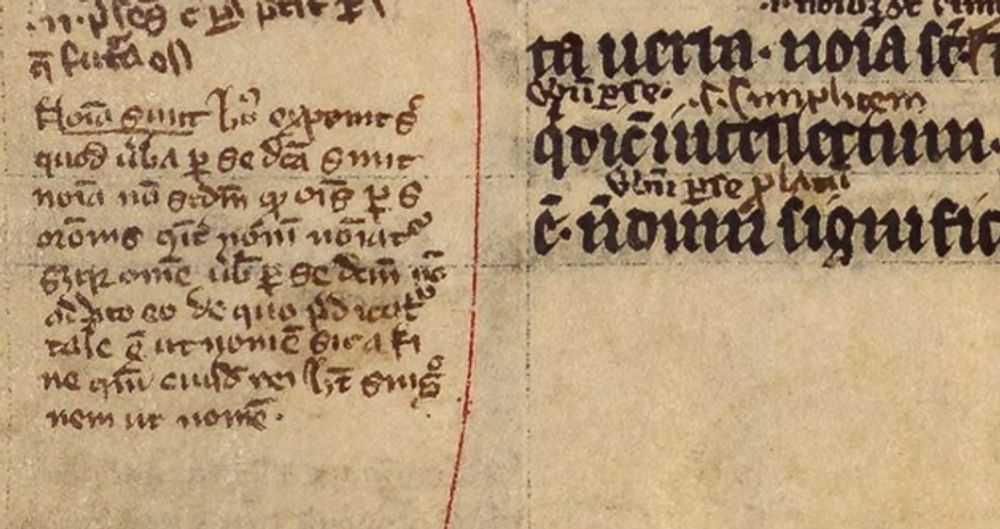
https://gallica.bnf.fr/ark:/12148/btv1b525053525
In the bottom margin of fol. 4v, we find a kind of diagram that often appears in these logical texts: the start of a sentence is broken up in two possible continuations, one of which is again broken up in a set of possible continuations.
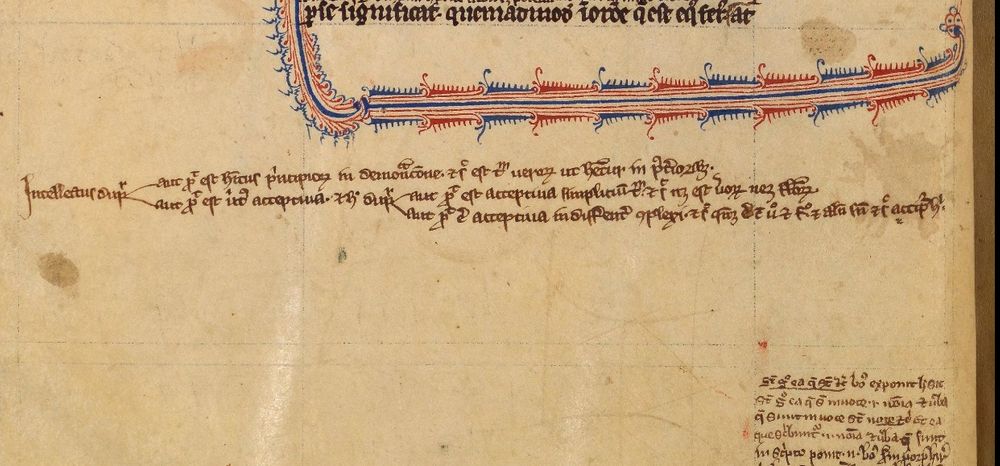
https://gallica.bnf.fr/ark:/12148/btv1b525053525
In the bottom margin of fol. 8v and on fol. 9r, we find more examples of such ‘horizontal’ diagrams. It shows the thought experiments Aristotle’s text provokes, going from one part of a sentence to the next and thinking through how they are connected. Yet they are visualized with different shapes.
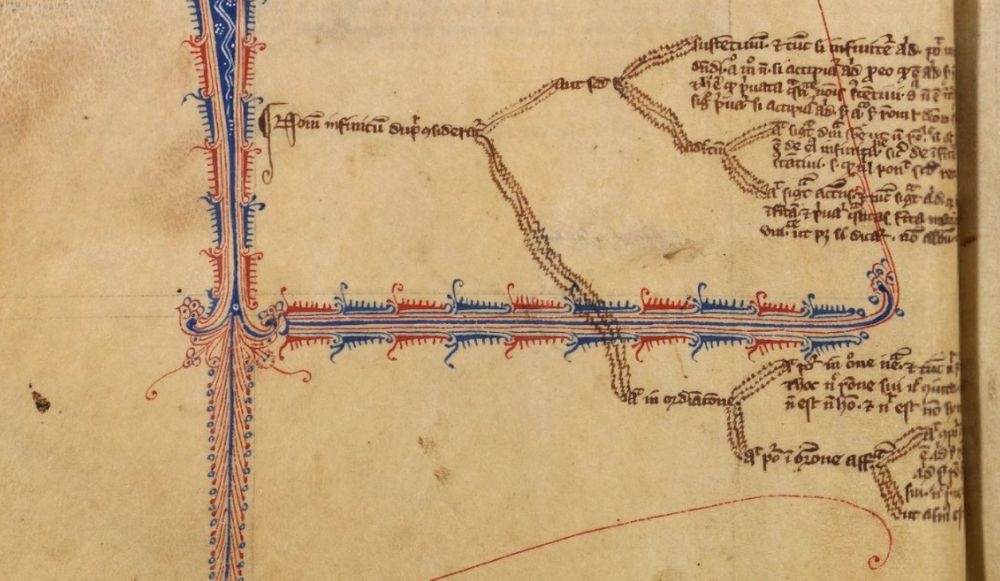

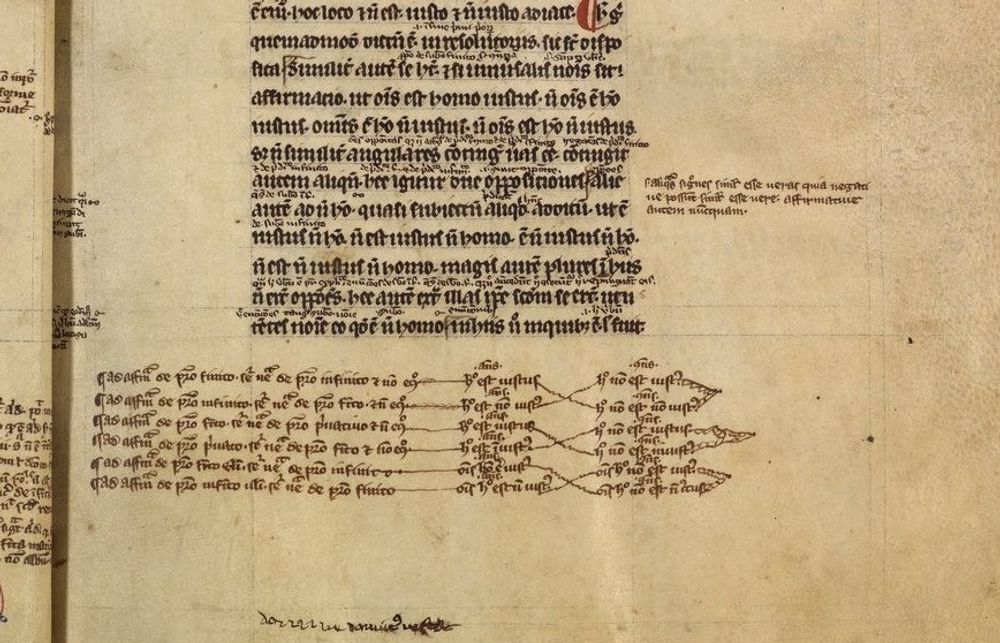

https://gallica.bnf.fr/ark:/12148/btv1b525053525
https://gallica.bnf.fr/ark:/12148/btv1b525053525
In the margin, different hands are clearly distinguishable by their individual scripts (on the image hand 1 is marked in red, hand 2 in green, hand 3 in yellow). Hand 3 uses a maniculum or pointing hand to mark a point of interest. The presence of different hands implies that the text was read by several successive students.
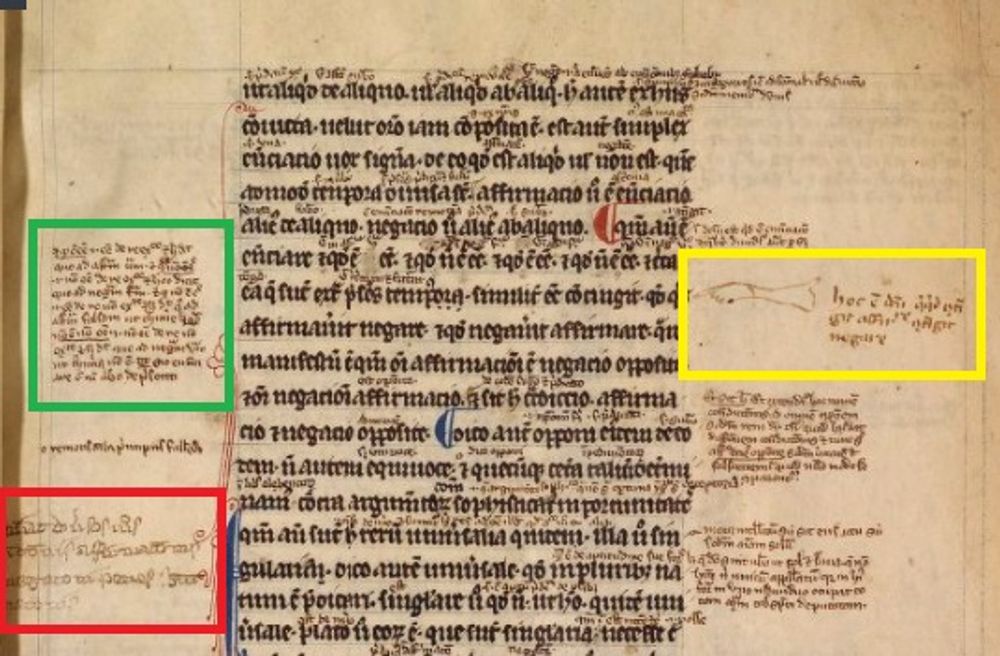
https://gallica.bnf.fr/ark:/12148/btv1b525053525
Texts from the logica nova, such as the opening of Aristotle’s Analytica priora and posteriora on f. 164v and 218r), are laid out in the same manner as texts from the logica vetus: with the grid of blocks provided for commentary, multiple layers, and large decorated initials.
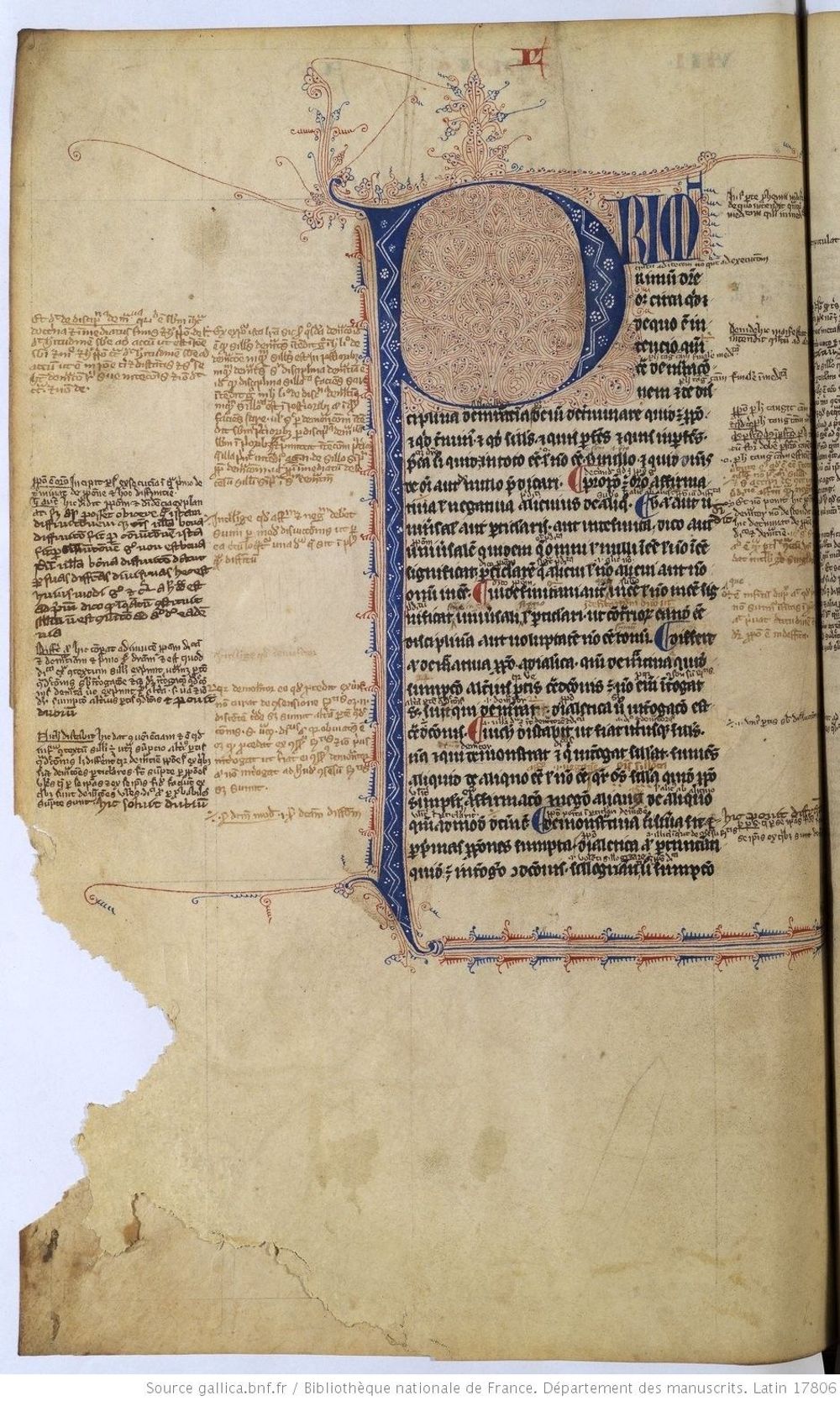
https://gallica.bnf.fr/ark:/12148/btv1b525053525

https://gallica.bnf.fr/ark:/12148/btv1b525053525
On some pages, such as here on fol. 44v, the notes are given extra charm with heads drawn in red or brown ink, some also with some extra colour. Perhaps this made it easier for the reader to remember or retrieve specific passages.

https://gallica.bnf.fr/ark:/12148/btv1b525053525
A teaching scene at the bottom of fol. 17r, showing a teacher on the left and a student on the floor in front of him, reminds us of the context in which this manuscript functioned: the medieval university.

https://gallica.bnf.fr/ark:/12148/btv1b525053525
Several drawings and painted illuminations in this book illustrate the school context of the book. On fol. 172r we find a line drawing of a master teaching five students. Just as in the previous image, he does not have a book to teach from, but is clearly explaining something and using gestures to get his message across. Note that both in the previous image and in this one, the teacher is a monk, with a monk’s cloak and shaved head, and so are the students.
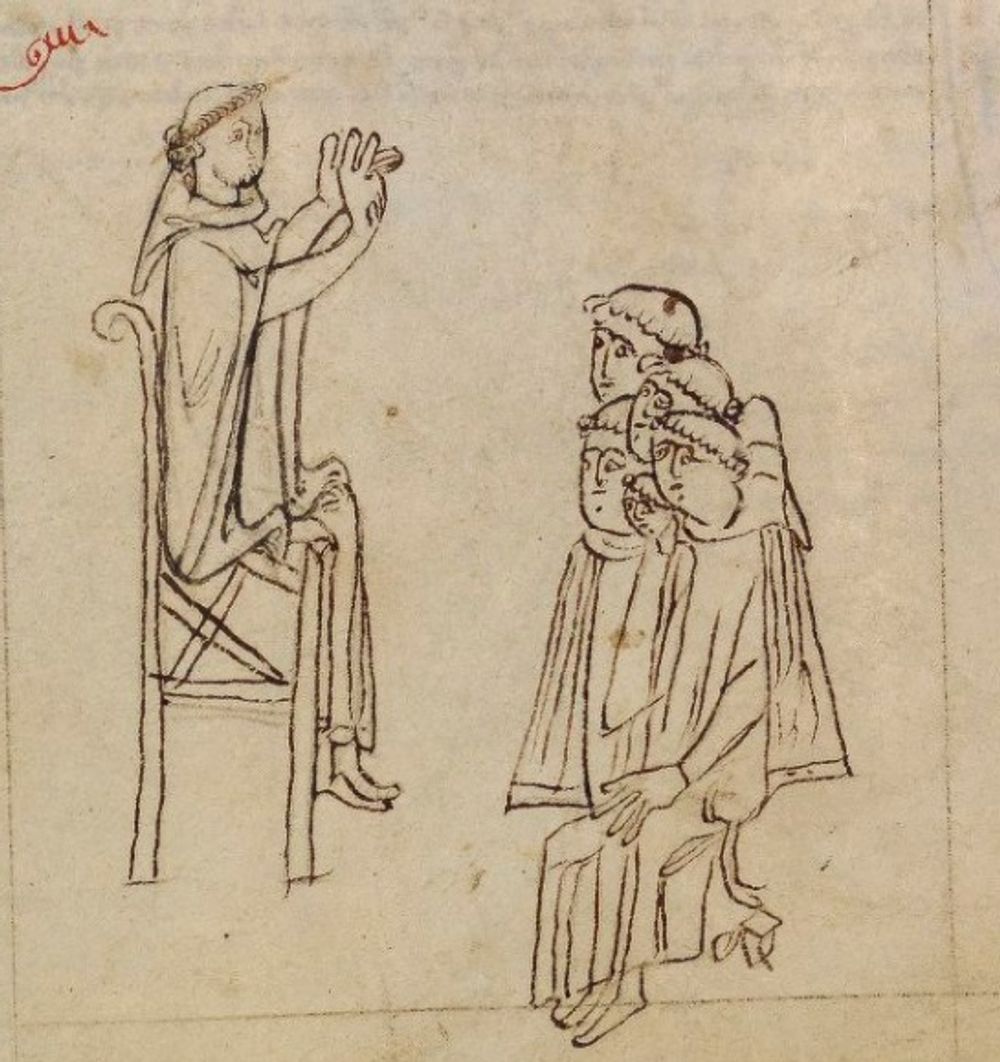
https://gallica.bnf.fr/ark:/12148/btv1b525053525
On fol. 250v, finally, we find two students debating: perhaps they are engaged in an exercise preparing them for the disputatio. Their gestures suggest that they are arguing, and so does the text below which they are placed: it is Aristotle’s Categories, which offers the fundamentals for the art of arguing.

https://gallica.bnf.fr/ark:/12148/btv1b525053525
Sources used for this contribution:
- N.J. Morgan, Early Gothic Manuscripts 1250-1285, Vol. II, London: Harvey Miller Publishers, 1988, p. 125.
- ‘Notice de catalogue’ at Gallica: http://archivesetmanuscrits.bnf.fr/ark:/12148/cc605719
- About teaching and texts at the medieval university: O. Weijers, Le maniement du savoir. Pratiques intellectuelles à l’époque des premières universités (XIIIe-XIVe siècles) (Studia Artistarum Subsidia, Turnhout: Brepols, 1996.
- Erik Kwakkel, “Helping hands on the page”, in Books Before Print, Leeds: ARC Humanities Press, 2018, 129-134.
Contribution by Mariken Teeuwen.
Cite as, Mariken Teeuwen, “Paris, BnF, lat. 17806”, The art of reasoning in medieval manuscripts (Dec 2020), https://art-of-reasoning.huygens.knaw.nl/lat17806. ↑


